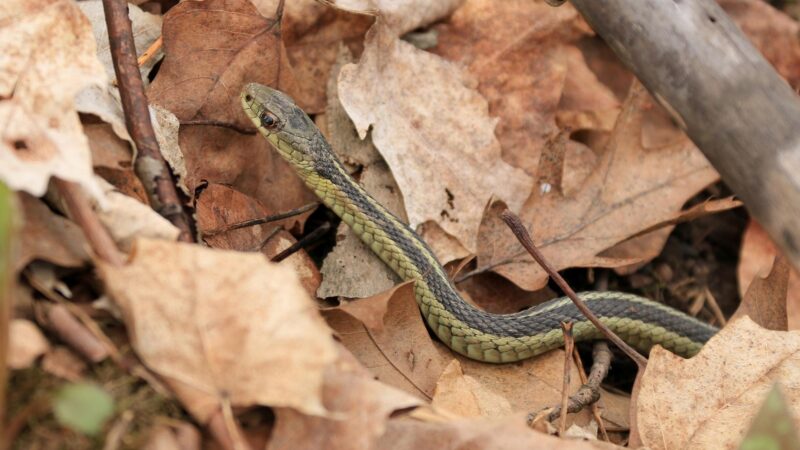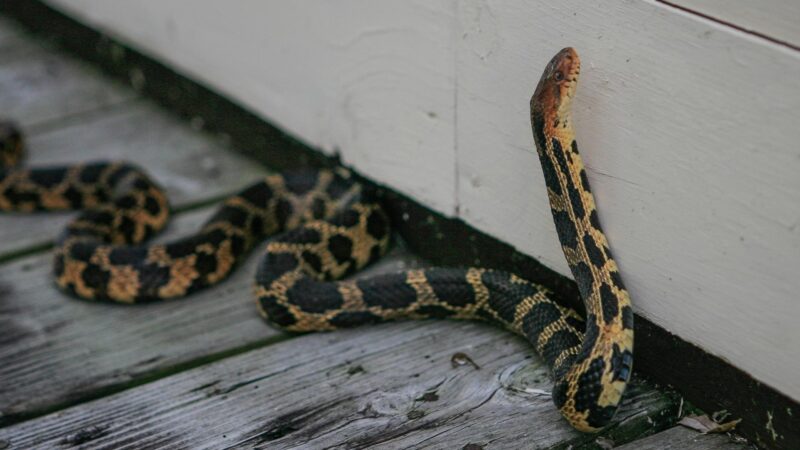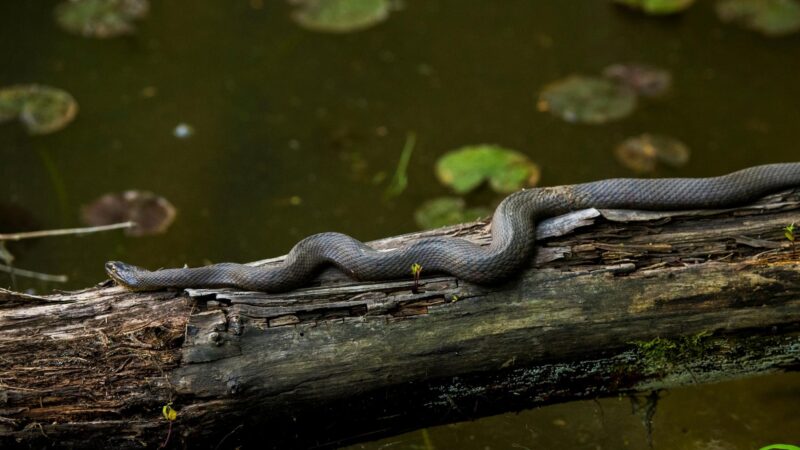Disease-carrying rodents live around riverways, streams, and other watersheds. These creatures can cause unsanitary conditions, but they’re stopped by their predators, such as water snakes.
Although these snakes look scary, they’re not venomous. They can bite when touched as they tend to become agitated easily.
What are the water snakes in Ohio? The water snakes in Ohio are Kirtland’s snake, Common Ribbonsnake, Eastern Foxsnake, Copper-Bellied water snake, Lake Erie water snake, Common water snake, and Queensnake. These water snakes live in and near water.
As long as you leave these water snakes in Ohio on their own, they won’t harm you. Just let them do their job of eliminating pests like rodents. If the population of these critters grows, diseases will likely be widespread.
Hence, water snakes can stop these diseases by preying on the carriers. To not panic when you see them, you need to know how to identify them by the following descriptions.
Table of Contents
Are Water Snakes Poisonous in Ohio?
Water snakes in Ohio are not generally poisonous or venomous. There are three venomous snakes in Ohio, namely Eastern Massasauga Rattlesnake, Northern Copperhead, and Timber Rattlesnake.
7 Water Snakes in Ohio
Kirtland’s Snake
The favorite habitat of this snake is open dam areas like wet fields and marsh edges. However, it also ventures into the outskirts of big cities. This species is relatively less aquatic than the others. When it’s scared, its body becomes flat as a defense mechanism.
- Scientific Name: Clonophis kirtlandii
- Appearance: The upper body of Kirtland’s snake is gray with two small rows of dark blotches and another large row of dark blotches. The large blotches are in the midline. It has a red belly with block spots on each margin. While its head is dark, the chin and throat are white.
- Color: Gray, red, white
- Lifespan: Up to 8 years
- Length: Around 2 feet
- Diet: Slugs, earthworms
- Place of Origin: Nearctic region
- Venomous: No
Common Ribbonsnake

This species is related to the garter snake, but you can distinguish it by its slender form, relatively long tail, and glossy scales. It’s shy, but it has a defense mechanism like any animal.
When handled roughly or disturbed, it can release foul smells and feces. It will try to escape by shedding its skin to create confusion.
- Scientific Name: Thamnophis sauritus
- Appearance: Common ribbon snakes can have a black, reddish-brown, or tan body with stripes that are green, light blue, yellow, or brown. Their bellies are usually light colors, but some may have black or dark brown.
- Color: Black, reddish-brown, tan
- Lifespan: Up to 10 years
- Length: 1.5 to 2.8 feet
- Diet: Fish, frogs, salamanders, newts, caterpillars, earthworms, spiders, carrion
- Place of Origin: North America
- Venomous: No
Eastern Foxsnake

Unfortunately, this snake is killed because people make mistakes by distinguishing it from the venomous copperhead snake. It’s docile and it doesn’t like confrontation, even when threatened.
It has a high chance to retreat. Before excreting a bad-smelling substance, it makes a sound similar to a rattlesnake as the leaves behind it rustle.
- Scientific Name: Pantheropis gloydi
- Appearance: Both genders look similar, with scales that vary from light brown to yellow. There are dark blotches that appear like chocolate or black. They have a yellow with a black checkered belly.
- Color: Yellow, light or dark brown, chocolate or black, reddish
- Lifespan: 8 to 17 years
- Length: .30 to .50 feet
- Diet: Birds, eggs, amphibians, small rodents, or mammals
- Place of Origin: Nearctic region
- Venomous: No
Copper-Bellied Water Snake

Compared to other water snakes, this one spends less time in the water. It prefers to hang itself in a tree or stay on a rock to wait for a meal over the waters.
Even though it’s non-venomous, its bite can still be painful. It can only happen when you try to touch it.
- Scientific Name: Nerodia erythrogaster neglecta
- Appearance: The dark color on its back fades near the belly area where the red or orange color is displayed. You’ll also see it with a divided anal plate.
- Color: Orange, red, black
- Lifespan: Unknown
- Length: 2.5 to 4 feet
- Diet: Amphibians like frogs and tadpoles, fish
- Place of Origin: North America
- Venomous: No
Lake Erie Water Snake
This species is an excellent swimmer, but it doesn’t swim often because it stays three meters underwater, where it hunts for food.
It’s easy for this snake to swallow a small fish with its head first. But when it catches a large fish, it will take it to the shore for consumption to begin.
- Scientific Name: Nerodia sipedon insularum
- Appearance: You can easily avoid mistakenly recognizing the Lake Erie water snake from the Northern water snake and Eastern Foxsnake as it’s large with a heavy body. Its color is uniform compared to those two snakes. Note that its back is gray, brownish, or greenish with dark markings, while the belly is white or yellowish.
- Color: Gray, greenish, brown
- Lifespan: Up to 12 years
- Length: 1.4 to 4 feet
- Diet: Fish
- Place of Origin: North America
- Venomous: No
Common Water Snake

Also known as Northern water snakes, they’re only social during spring and fall as they’re coiled together in basking sites. They thrive individually in warm months. Furthermore, you’ll find them basking in the warmth of the shallow water, walkways, branches, dried cattail stems, and beaver lodges.
- Scientific Name: Nerodia Sipedon
- Appearance: This is another dark-colored snake that is either brownish, grayish, or tan. There are square blotches that form several bands on their back and sides. Then, it has a belly that is white, orange, or yellow.
- Color: Tan, brownish, gray, yellow, orange
- Lifespan: Around 9 years
- Length: 2 to 4.6 feet
- Diet: Amphibians, birds, mammals, insects, reptiles, fish, carrion, aquatic crustaceans, terrestrial non-insect arthropods
- Place of Origin: Nearctic region
- Venomous: No
Queensnake
Queen snakes are solitary when they’re not in the breeding season and hibernate in the cold season. They usually occupy shallow waters, especially the area with a lot of crayfish.
- Scientific Name: Regina septemvittata
- Appearance: The upper side of the Queensnake is olive or brownish. You’ll also see yellow horizontal bands on its labial scales and sides.
- Color: Olive, brownish, yellow
- Lifespan: Up to 19 years
- Length: 1.12 to 3 feet
- Diet: Aquatic crustaceans, amphibians, fish
- Place of Origin: Nearctic region
- Venomous: No
Frequently Asked Questions
Are There Any Water Snakes in Ohio?
There are water snakes in Ohio, such as Kirtland’s snake, Common Ribbonsnake, Eastern Foxsnake, Copper-Bellied water snake, Lake Erie water snake, Common water snake, and Queensnake. Among these non-venomous species, the Common water snake is the most abundant.
Can Water Snakes Hurt You?
You should know that water snakes generally don’t have venom, but they can bite when feeling threatened. Try to pick it up, and it will surely bite you. Whether it’s a small or large water snake, it can inflict more than scratches. With its set of teeth, its bite can be painful.
Therefore, just don’t meddle with any water snakes that you see. Let them do their course as most of them distance themselves from humans.
Are Water Snakes Protected in Ohio?
Water snakes are protected in Ohio through the ‘Dangerous Wild Animal Act’ signed by the governor on June 5, 2012. The revision was made on January 1, 2014, that allows a person to own a dangerous wild animal. He or she must be authorized with an unexpired permit from wildlife propagation or shelter.
When it comes to possessing a water snake, you have to apply for a permit and submit it to the Ohio Department of Agriculture. Still, the selling, trade, and transfer of ownership are not allowed under the said act.
Summary
Lake Erie in Ohio has been home to the water snakes featured in this article. Of course, you can also find them in some areas where they are favorable for snakes.
The water snake species found in Ohio are small, medium-sized, and large. Despite the size difference, they’re all non-venomous. You shouldn’t try to touch them as they can still bite.
Related: 6 Water Snakes in Michigan | The Ultimate Guide
List of Sources
Gibbons, W. (2002). Water Snakes Are Much Maligned. University of Georgia.
Dewey, T. (2008). Regina septemvittata. Animal Diversity Web.
Kauzlarich, K. (2000). Clonophis kirtlandii. Animal Diversity Web.
Hill, J. (2007). Pantherophis gloydi. Animal Diversity Web.
Copperbelly Water Snake. University of Kentucky.